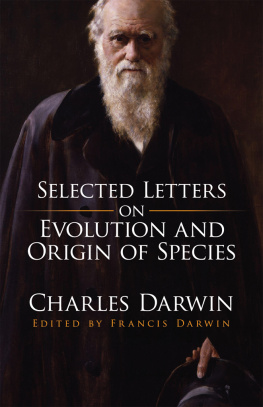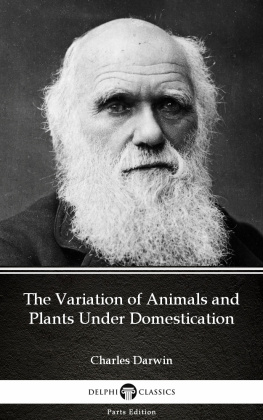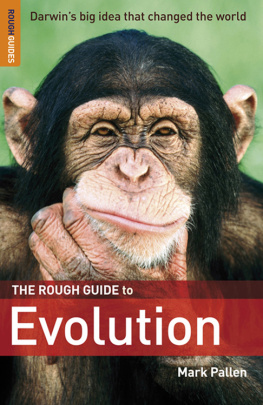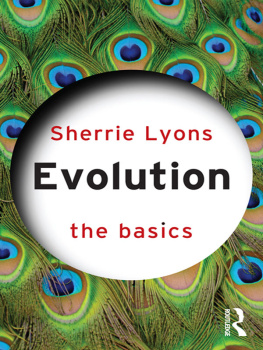SELECTED LETTERS
ON
EVOLUTION AND ORIGIN OF SPECIES
CHARLES DARWIN
EDITED BY
FRANCIS DARWIN
DOVER PUBLICATIONS, INC.
MINEOLA, NEW YORK
Bibliographical Note
This Dover edition, first published in 2018, is an unaltered and unabridged republication of Charles Darwin: His Life Told in an Autobiographical Chapter and in a Selected Series of His Published Letters, originally published in 1892 by D. Appleton and Company, New York.
Library of Congress Cataloging-in-Publication Data
Names: Darwin, Charles, 18091882, author. | Darwin, Francis, Sir, 18481925, editor. | Darwin, Charles, 18091882. Life and letters of Charles Darwin.
Title: Charles Darwin: his life told in an autobiographical chapter and in a selected series of his published letters / Charles Darwin; edited by Francis Darwin.
Other titles: Publishers added title: Selected letters on evolution and origin of species
Description: Dover edition | Mineola, New York: Dover Publications, Inc., 2018. | Originally published: New York: D. Appleton and Company, 1892. | Similar to: Life and letters of Charles Darwin.
Identifiers: LCCN 2017053247 | ISBN 9780486826516 | ISBN 0486826511
Subjects: LCSH: Darwin, Charles, 18091882. | NaturalistsGreat BritainBiography.
Classification: LCC QH31.D2 A7 2018 | DDC 576.8/2092 [B]dc23
LC record available at https://lccn.loc.gov/2017053247
Manufactured in the United States by LSC Communications
82651101 2018
www.doverpublications.com
TO DR. HOLLAND, ST. MORITZ.
13th July, 1892.
DEAR HOLLAND,
This book is associated in my mind with St. Moritz (where I worked at it), and therefore with you.
I inscribe your name on it, not only in token of my remembrance of your many acts of friendship, but also as a sign of my respect for one who lives a difficult life well.
Yours gratefully,
FRANCIS DARWIN.
PREFACE.
IN preparing this In certain periods of my fathers life the scientific and the personal elements run a parallel course, rising and falling together in their degree of interest. Thus the writing of the Origin of Species, and its publication, appeal equally to the reader who follows my fathers career from interest in the man, and to the naturalist who desires to know something of this turning point in the history of Biology. This part of the story has therefore been told with nearly the full amount of available detail.
In arranging my material I have followed a roughly chronological sequence, but the character and variety of my fathers researches make a strictly chronological order an impossibility. It was his habit to work more or less simultaneously at several subjects. Experimental work was often carried on as a refreshment or variety, while books entailing reasoning and the marshalling of large bodies of facts were being written. Moreover many of his researches were dropped only to be resumed after years had elapsed. Thus .
With regard to ., in which I have attempted to give an account of my fathers manner of working, I may be allowed to say that I acted as his assistant during the last eight years of his life, and had therefore an opportunity of knowing something of his habits and methods.
It is pleasure to me to acknowledge the kindness of Mr. Cameron who has allowed me to reproduce the late Mrs. Camerons fine photograph of my father as a frontispiece.
FRANCIS DARWIN.
WYCHFIELD, CAMBRIDGE,
August, 1892.
I have not thought it necessary to indicate all the omissions in the abbreviated letters.
This photograph has been omitted in this edition.
TABLE OF CONTENTS.
APPENDICES.

Facsimile of a page from a notebook of 1837 (see transcript opposite)
FROM A NOTEBOOK OF 1837.
TRANSCRIPT FROM FACSIMILE OF HANDWRITING ON OPPOSITE PAGE.
led to comprehend true affinities. My theory would give zest to recent & Fossil Comparative Anatomy: it would lead to study of instincts, heredity, & mind heredity, whole metaphysics, it would lead to closest examination of hybridity & generation, causes of change in order to know what we have come from & to what we tend, to what circumstances favour crossing & what prevents it, this and direct examination of direct passages of structure in species, might lead to laws of change, which would then be main object of study, to guide our speculations.
For myself I found that I was fitted for nothing so well as for the study of Truth; ... as being gifted by nature with desire to seek, patience to doubt, fondness to meditate, slowness to assert, readiness to reconsider, carefulness to dispose and set in order; and as being a man that neither affects what is new nor admires what is old, and that hates every kind of imposture. So I thought my nature had a kind of familiarity and relationship with Truth.BACON (Proem to the Interpretatio Natur).
SELECTED LETTERS
ON
EVOLUTION AND ORIGIN OF SPECIES
CHARLES DARWIN.
CHAPTER I.
THE DARWINS.
CHARLES ROBERT DARWIN was the second son of Dr. Robert Waring Darwin, of Shrewsbury, where he was born on February 12, 1809. Dr. Darwin was a son of Erasmus Darwin, sometimes described as a poet, but more deservedly known as physician and naturalist. Charles Darwins mother was Susannah, daughter of Josiah Wedgwood, the well-known potter of Etruria, in Staffordshire.
If such speculations are permissible, we may hazard the guess that Charles Darwin inherited his sweetness of disposition from the Wedgwood side, while the character of his genius came rather from the Darwin grandfather.
Robert Waring Darwin was a man of well-marked character. He had no pretensions to being a man of science, no tendency to generalise his knowledge, and though a successful physician he was guided more by intuition and everyday observation than by a deep knowledge of his subject. His chief mental characteristics were his keen powers of observation, and his knowledge of men, qualities which led him to read the characters and even the thoughts of those whom he saw even for a short time. It is not therefore surprising that his help should have been sought, not merely in illness, but in cases of family trouble and sorrow. This was largely the case, and his wise sympathy, no less than his medical skill, obtained for him a strong influence over the lives of a large number of people. He
We have a miniature of his wife, Susannah, with a remarkably sweet and happy face, bearing some resemblance to the portrait by Sir Joshua Reynolds of her father; a countenance expressive of the gentle and sympathetic nature which Miss Meteyard ascribes to her. She died July 15, 1817, thirty-two years before her husband, whose death occurred on November 13, 1848. Dr. Darwin lived before his marriage for two or three years on St. Johns Hill, afterwards at the Crescent, where his eldest daughter Marianne was born, lastly at the Mount, in the part of Shrewsbury known as Frankwell, where the other children were born. This house was built by Dr. Darwin about 1800, it is now in the possession of Mr. Spencer Phillips, and has undergone but little alteration. It is a large, plain, square, redbrick house, of which the most attractive feature is the pretty green-house, opening out of the morning-room.
The house is charmingly placed, on the top of a steep bank leading down to the Severn. The terraced bank is traversed by a long walk, leading from end to end, still called the Doctors Walk. At one point in this walk grows a Spanish chestnut, the branches of which bend back parallel to themselves in a curious manner, and this was Charles Darwins favourite tree as a boy, where he and his sister Catharine had each their special seat.
















